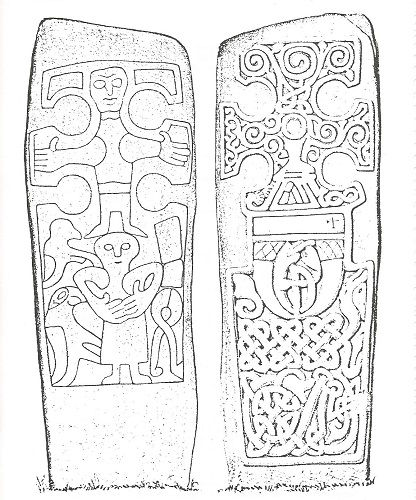
This magnificent cross-slab from the Viking Age stands in the churchyard of Kirkcolm in the Rhinns of Galloway. I blogged about it two years ago, reproducing a nineteenth-century drawing (see below) together with photographs from Allen and Anderson’s Early Christian Monuments of Scotland (published in 1903). Here’s an extract from my description of the carvings:
‘On one side, the hammerhead cross carries a rough representation of the Crucified Christ. Another figure stands below, flanked by two birds, a set of blacksmith’s tongs and an unidentified rectangular shape. It has been suggested that this lower figure is the Scandinavian hero Sigurd, juxtaposed with the Crucifixion to highlight the mingling of pagan and Christian beliefs in a region colonised by Vikings. On the other side of the slab, the hammerhead cross is decorated with spiral patterns, below which are two horns, a coiled serpent and a panel of interlace terminating in a pair of snakes.’

Illustration from J. Stuart’s Sculptured Stones of Scotland
After describing the stone I added these words: Having not yet visited the Kilmorie Cross I don’t have any photographs of my own to accompany this blogpost. This situation can now be remedied. A recent holiday in Galloway has given me an opportunity to see the monument in all its glory.

The hammerhead cross on the front of the slab.

Interlace patterns on the front face.

The rear of the slab.

The Christ figure.

The pagan figure (possibly representing Sigurd?)

Kirkcolm Church

Visitors to the church are invited to view its Dark Age monument.
* * * * *
Photographs in this blogpost are copyright © B Keeling.
My original post on the Kilmorie Cross can be found via this link.
* * * * * * *

It’s nice to see the original in all its glory. Great pictures. !!
Thanks Rita. I was glad to tick it off my list of “must see” stones.
Fantastic! What a wonderful cross, and I’m glad you finally got to see it. I’m interested in that hole in the centre, but maybe you have discussed that before?!
The hole in the cross-head is certainly a curious feature. Allen and Anderson in ECMS described it as “a circular depression with a small boss in the centre surrounded by scrolls of foliage”.
On the way there did you take a look at the Ruthwell Cross? Though why I should assume that you crossed Dumfriesshire to reach The Shire I don’t know.
(My mother always called Kirkcudbrightshire “The Stewartry”, and Wigtownshire “The Shire”. I’ve just googled and find that scholars would approve of her usage.
http://www.dsl.ac.uk/entry/dost/stewartry)
I didn’t know Wigtownshire was known as The Shire (as in the 1697 document cited on the webpage you found). An interesting historical snippet for Hobbit fans!
Didn’t visit Ruthwell on this holiday, though I’ve seen the cross a couple of times on previous trips and have a few photos. Probably something I should blog about in the near future.
How fabulous to see it in person. Great pictures!
Thanks. It was indeed a privilege to visit such a fine piece of Dark Age sculpture.